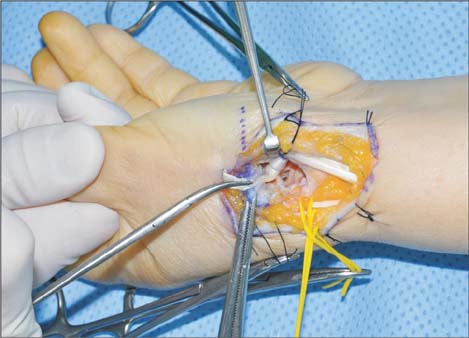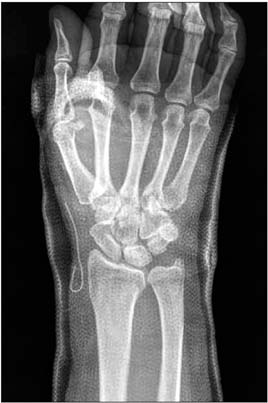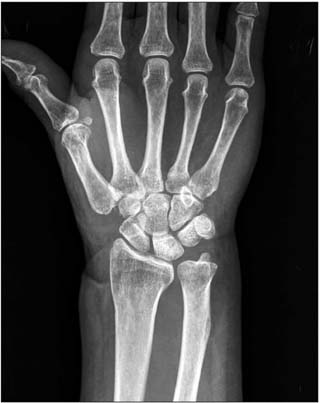Clin Orthop Surg.
2015 Sep;7(3):372-376. 10.4055/cios.2015.7.3.372.
Results of Abductor Pollicis Longus Suspension Ligamentoplasty for Treatment of Advanced First Carpometacarpal Arthritis
- Affiliations
-
- 1Department of Orthopaedic Surgery, Kyungpook National University Hospital, Daegu, Korea.
- 2Department of Orthopaedic Surgery, Daegu Park Hospital, Daegu, Korea.
- 3Korea Institute of Science and Technology, Seoul, Korea.
- 4University of Science and Technology, Daejeon, Korea.
- 5Department of Orthopaedic Surgery, Asan Medical Center, University of Ulsan College of Medicine, Seoul, Korea. jeonchoi@gmail.com
- 6Department of Orthopaedic Surgery, Kyemyung University Dongsan Medical Center, Daegu, Korea.
- KMID: 2234093
- DOI: http://doi.org/10.4055/cios.2015.7.3.372
Abstract
- BACKGROUND
Suspension ligamentoplasty using abductor pollicis longus (APL) tendon without bone tunneling, was introduced as one of the techniques for treatment of advanced first carpometacarpal (CMC) arthritis. The purpose of this study was to evaluate the radiologic and clinical results of APL suspension ligamentoplasty.
METHODS
The medical records of 19 patients who underwent APL suspension ligamentoplasty for advanced first CMC arthritis between January 2008 and May 2012 were reviewed retrospectively. The study included 13 female and 6 male patients, whose mean age was 62 years (range, 43 to 82 years). For clinical evaluation, we assessed the grip and pinch power, radial and volar abduction angle, thumb adduction (modified Kapandji index), including visual analogue scale (VAS) and Disabilities of the Arm, Shoulder and Hand (DASH) scores. Radiologic evaluation was performed using simple radiographs.
RESULTS
The mean follow-up was 36 months (range, 19 to 73.7 months). Mean power improved from 18.3 to 27 kg for grip power, from 2.8 to 3.5 kg for tip pinch, and from 4.3 to 5.4 kg for power pinch. All patients showed decreased VAS from 7.2 to 1.7. Radial abduction improved from 71degrees preoperatively to 82degrees postoperatively. The modified Kapandji index showed improvement from 6 to 7.3, and mean DASH was improved from 41 to 17.8. The height of the space decreased from 10.8 to 7.1 mm. Only one case had a complication involving temporary sensory loss of the first dorsal web space, which resolved spontaneously.
CONCLUSIONS
The APL suspension ligamentoplasty for treatment of advanced first CMC arthritis yielded satisfactory functional results.
MeSH Terms
Figure
Reference
-
1. Cooney WP 3rd, Chao EY. Biomechanical analysis of static forces in the thumb during hand function. J Bone Joint Surg Am. 1977; 59(1):27–36.
Article2. Gervis WH, Wells T. A review of excision of the trapezium for osteoarthritis of the trapezio-metacarpal joint after twenty-five years. J Bone Joint Surg Br. 1973; 55(1):56–57.
Article3. Murdoch G. Errors of diagnosis revealed at meniscectomy. J Bone Joint Surg Br. 1957; 39(3):502–507.
Article4. Belcher HJ, Nicholl JE. A comparison of trapeziectomy with and without ligament reconstruction and tendon interposition. J Hand Surg Br. 2000; 25(4):350–356.
Article5. Davis TR, Brady O, Dias JJ. Excision of the trapezium for osteoarthritis of the trapeziometacarpal joint: a study of the benefit of ligament reconstruction or tendon interposition. J Hand Surg Am. 2004; 29(6):1069–1077.
Article6. Field J, Buchanan D. To suspend or not to suspend: a randomised single blind trial of simple trapeziectomy versus trapeziectomy and flexor carpi radialis suspension. J Hand Surg Eur Vol. 2007; 32(4):462–466.
Article7. Downing ND, Davis TR. Trapezial space height after trapeziectomy: mechanism of formation and benefits. J Hand Surg Am. 2001; 26(5):862–868.
Article8. Tomaino MM. Basal metacarpal osteotomy for osteoarthritis of the thumb. J Hand Surg Am. 2011; 36(6):1076–1079.
Article9. Mathoulin C, Moreel P, Costa R, Wilson SM. Abductor pollicis longus "hammock" ligamentoplasty for treatment of first carpometacarpal arthritis. J Hand Surg Eur Vol. 2008; 33(3):292–297.
Article10. Eaton RG, Littler JW. Ligament reconstruction for the painful thumb carpometacarpal joint. J Bone Joint Surg Am. 1973; 55(8):1655–1666.
Article11. Kapandji A. Clinical test of apposition and counter-apposition of the thumb. Ann Chir Main. 1986; 5(1):67–73.12. Eaton RG, Lane LB, Littler JW, Keyser JJ. Ligament reconstruction for the painful thumb carpometacarpal joint: a long-term assessment. J Hand Surg Am. 1984; 9(5):692–699.
Article13. Brunelli G, Monini L, Brunelli F. Stabilisation of the trapezio-metacarpal joint. J Hand Surg Br. 1989; 14(2):209–212.
Article14. Kaarela O, Raatikainen T. Abductor pollicis longus tendon interposition arthroplasty for carpometacarpal osteoarthritis of the thumb. J Hand Surg Am. 1999; 24(3):469–475.
Article15. Sigfusson R, Lundborg G. Abductor pollicis longus tendon arthroplasty for treatment of arthrosis in the first carpometacarpal joint. Scand J Plast Reconstr Surg Hand Surg. 1991; 25(1):73–77.
Article16. Sirotakova M, Figus A, Elliot D. A new abductor pollicis longus suspension arthroplasty. J Hand Surg Am. 2007; 32(1):12–22.
Article17. Rutegard JN, Eriksson C, Olsson K. Tendon arthroplasty for treatment of trapeziometacarpal arthrosis. Scand J Plast Reconstr Surg Hand Surg. 1994; 28(4):295–298.
Article
- Full Text Links
- Actions
-
Cited
- CITED
-
- Close
- Share
- Similar articles
-
- Variations of Insertions of the Abductor Pollicis Longus and the Extensor Pollicis Brevis in Korean
- Idiopathic Rupture of the Extensor Pollicis Longus Tendon due to Carpometacarpal Joint Arthritis of the Thumb: A Case Report
- Evaluation of Anti-Subsidence Effect of Abductor Pollicis Longus Suspensionplasty in Carpometacarpal Arthritis of the Thumb
- A Variant Extensor Pollicis Brevis Crossing the Anatomical Snuff Box
- Traumatic Buttonhole Deformity of the Thumb




